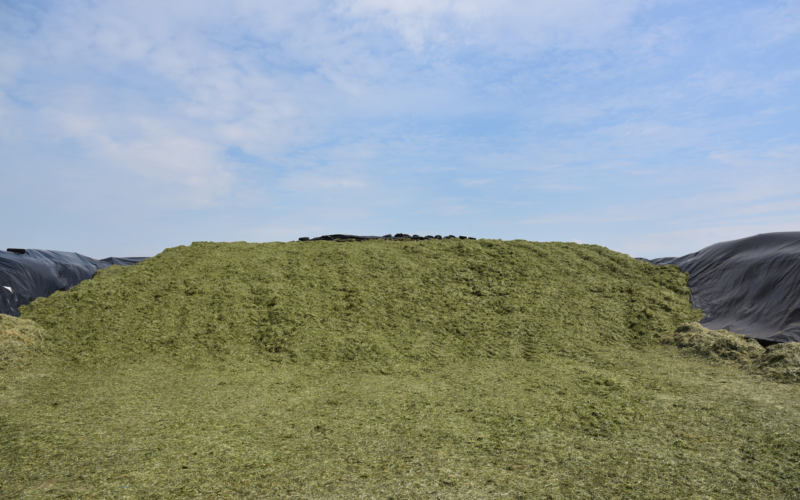Any structures currently in use that were built, substantially reconstructed, or enlarged after 1st September 1991 should already be compliant with a basic set of construction standards. If you are still using structures that were built before September 1991 you must ensure that they are structurally sound, have an impermeable floorslab and an adequate effluent collection system.
The Controlled Activities Regulations (CAR) were updated in January 2022 and included new General Binding Rules (GBRs) on the storage of silage. The regulations had a transitional period to allow businesses to make any required upgrades to ensure compliance by 1st Jan 2024. It’s important to remember that under these Regulations the term “silage” covers any forage crop (food grown for feeding livestock, including draff, or for use in energy production) which is being, or has been, conserved by fermentation or preservation or both, including the use of additives.
If you are planning to build, substantially reconstruct, or enlarge any structure used for making silage or tank used to contain silage effluent it is now a legal requirement that you consult with a suitably qualified engineer and provide SEPA with the engineering plan at least 30 days prior to any work commencing. Failure to do this could be costly in both time and money to your business.
Things to Consider
Location – all parts of any silage pit and effluent collection system must be sited more than 10metres away from any surface water or surface water drains. Think about where any field drains are and if they require to be cut off or rerouted.
Roofing – although an added expense, reducing the rainfall that falls onto the pit reduces the volume of effluent produced that must be collected and contained benefiting the whole farm management system.
Floorslab – the floorslab must be strong enough to withstand the loads from farm machinery and robust enough to withstand impact from the front teeth of front loaders or similar equipment. It must be impermeable and resistant to attack from silage effluent. Concrete floors require reinforcement and need to cure, usually between 14-28 days depending on the concrete type, before use and must comply with British Standard EN 1992-3:200642 and British Standard EN-1-1-2004+A1:2014. Alternatively, hot rolled asphalt overlying a bitumen layer can be used to construct a floorslab which can be used within 24 hours and maybe cheaper per m2 in comparison to other construction materials they must comply with British Standard EN 13108-4:2016.
Effluent Collection – the minimum size of the effluent collection tank is dependant on the pit capacity. The tank must be impermeable and resistant to acid attack. If you intend to use a pump the tank must be fitted with an automatic overfill prevention device, with a dedicated electrical supply and alarm.
| Silage pit Capacity | Capacity of Effluent Tank |
| Less than 1500m3 | 20 litres for every 1m3 of clamp capacity |
| 1500m3 or greater | 30m3 plus an additional 6.7 litres for every 1m3 of the clamp capacity over 1500m |
Silage effluent which is from an opened pit and consists mainly of rainwater can be drained through a constructed farm wetland (CFW). Any proposals for a CFW must be discussed with SEPA.
Type of Pit
Silage pits are usually either of earth bank or concrete wall construction and each have different requirements. However, the Regulations do not require a silage pit to have walls all is required is an impermeable floor, effluent collection system and tank. You must retain the engineer’s final sign-off certificate for the works for the lifetime of the silage pit or effluent tank, for inspection by SEPA on request.
Earth Bank Pits
All earth bank pits must:
- Have an impermeable floor slab which is constructed with channels to ensure all silage effluent is collected and conveyed to an appropriate silage effluent collection tank.
- Have the earth bank walls lined with an impermeable membrane such as 1000-gauge polyethylene or a similar material.
- Not have any internal walls higher than 1m high.
- Be resistant to attack by silage effluent, especially the base and any channels or walls.
- Never be overfilled past any silage effluent collection channel.
- Be regularly maintained to ensure they are kept free from structural defects.
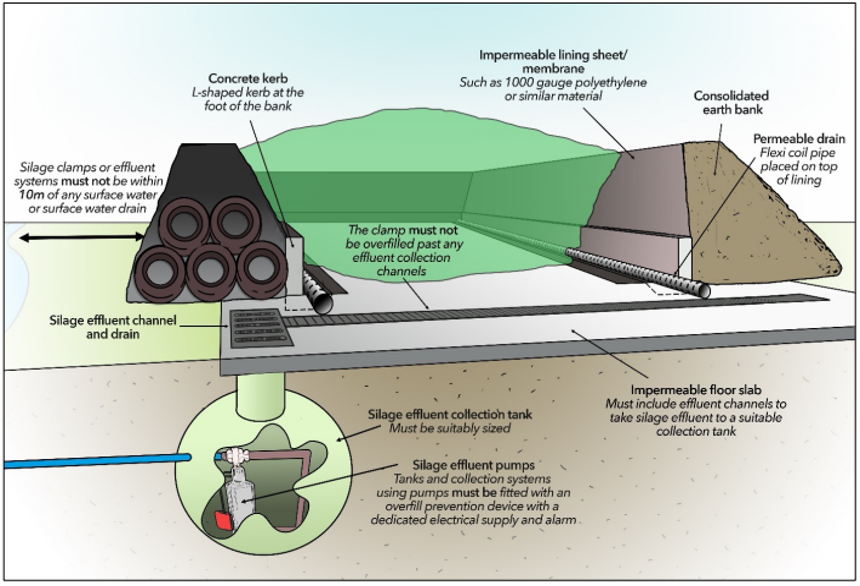
Concrete Pits
All concrete wall pits must
- Have an impermeable floor slab which extends beyond the walls and is constructed with channels to ensure all silage effluent is collected and conveyed to an appropriate effluent collection tank.
- Never have the stored silage, once compacted, above the height of the walls.
- Have the maximum loadings visibly displayed on the wall.
- Be resistant to attack by silage effluent, especially the base and any channels or walls.
- Never be overfilled past any silage effluent collection channel.
- Be regularly maintained to ensure they are kept free from structural defects.
- It is always best practice to coat the walls and the first 1 meter of the floor with bitumen paint.
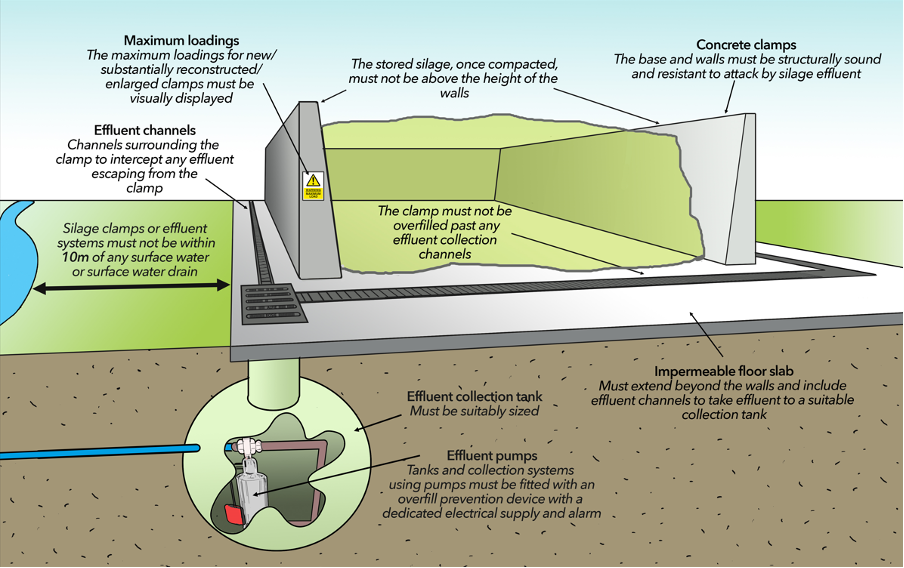
Remember, if you are planning to construct, substantially reconstruct, or enlarge any silage pit or effluent collection tank you must consult with a suitably qualified engineer and provide SEPA with the engineering plan at least 30 days prior to any work commencing.
If you need more information or advice about the silage structures on your farm, please contact SEPA at nationalrural@sepa.org.uk Further guidance and information can be found at www.farmingandwaterscotland.ork.org .
Related resources
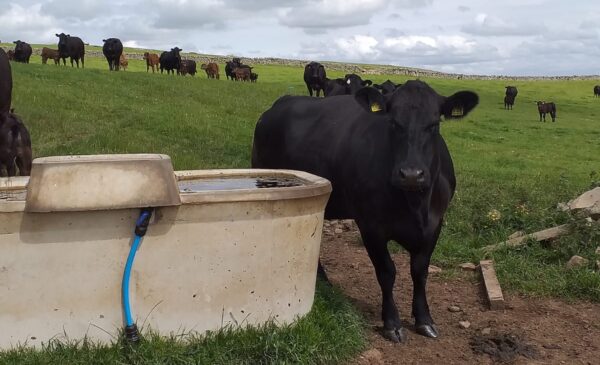
Newsletter Summer 24 Newsletter
You don’t always need a pump!
Robert Ramsay, SAC Consulting
Discussing alternative watering with farmers is always an enjoyable challenge. From crofters in the Western…

Newsletter Summer 24 Newsletter
Water Scarcity
Brian Roxburgh, SEPA
There is one clear message from the various studies predicting future rainfall patterns in Scotland:…
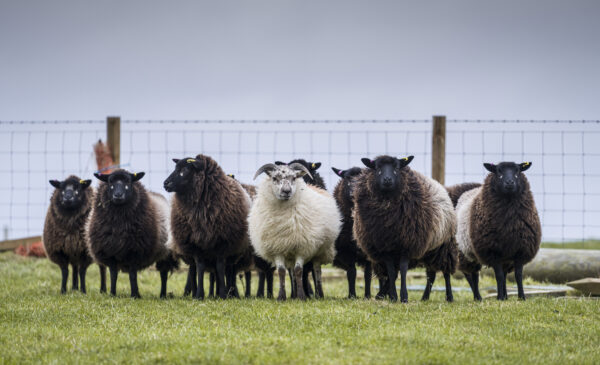
Newsletter Summer 24 Newsletter
Sheep Scab: Right way to dip sheep
Laura Henderson, SAC Consulting
What is sheep scab? Sheep scab is an allergic dermatitis in response to infestation with…

